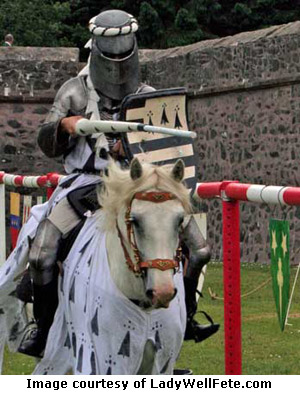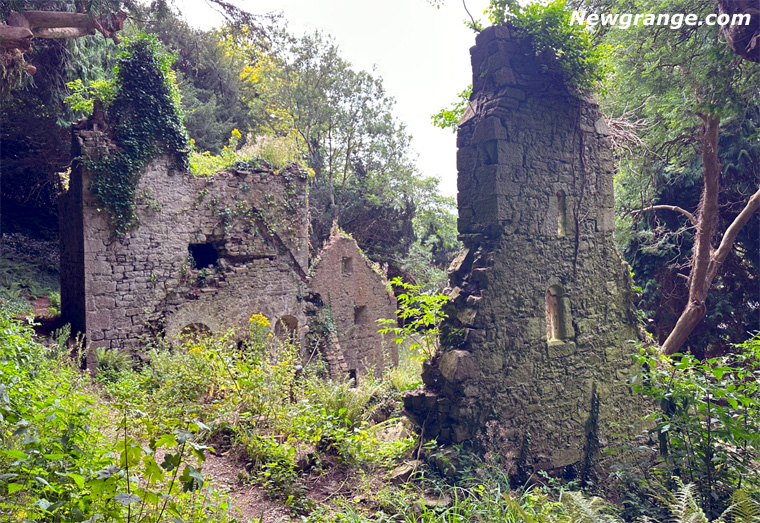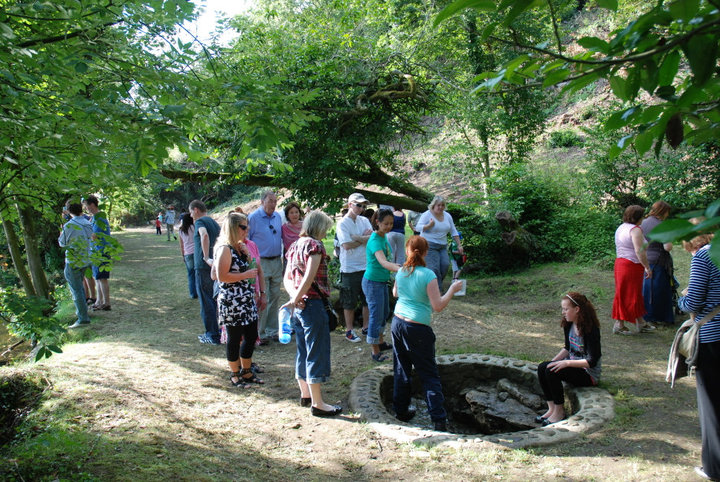The Lady Well Fete - Slane Castle August 19th 2012
 Jousting
Knights on warhorses, a medieval village and a 100ft inflatable
obstacle course will be some of the new attractions at this year's Lady Well
Fete to be held at Slane Castle on Sunday the 19th August. Now in its fifth
year, the festival has become a welcome family day out on the Meath calendar.
It includes a wide range of attractions including fly-fishing
demonstrations, vintage cars and tractors, pony and trap rides, castle tours, a
cake baking competition, arts and crafts stalls for the adults and giant bouncy
castles, zorb balls and bucking broncos for the kids. Those with dogs can enter
the dog shows and this year will see the launch of the Lady Well Scurry Cup
competition which is open to all gundogs.
Jousting
Knights on warhorses, a medieval village and a 100ft inflatable
obstacle course will be some of the new attractions at this year's Lady Well
Fete to be held at Slane Castle on Sunday the 19th August. Now in its fifth
year, the festival has become a welcome family day out on the Meath calendar.
It includes a wide range of attractions including fly-fishing
demonstrations, vintage cars and tractors, pony and trap rides, castle tours, a
cake baking competition, arts and crafts stalls for the adults and giant bouncy
castles, zorb balls and bucking broncos for the kids. Those with dogs can enter
the dog shows and this year will see the launch of the Lady Well Scurry Cup
competition which is open to all gundogs.
Lord Alex Mount Charles said "We are delighted to be able to offer a bigger and better event this year. There is hopefully something for everyone. Our aim is to give the people of Slane and beyond a great family day out and with the extra activities this year we plan to do just that. It is a genuine pleasure to be able to celebrate this as a community in the Castle grounds."
All of the activities will be centred around the day's sporting fixtures which include both senior and junior local GAA and soccer games. The highlight here is the now hotly contended senior GAA game between Slane and Rathkenny as they compete for the Village Inn Lady Well Trophy.
There are also fun races with prizes open to children of all ages. Getting round all of this will be tiring but there are loads of gourmet food stalls at which one can refresh and refuel and the day will then finish with the Duck Derby and its generous cash prizes.
All the proceeds from the Fete will go towards Slane Local Heroes which aims to improve the village of Slane and the quality of life of its residents.
The day kicks off at 1pm, for those coming by car, the entrance to the car park is on the N51 Slane-Navan road, just beyond the castle gates on the left hand side if coming from Slane village. The main pedestrian entrance is opposite Castle Gardens in Slane village. Food and toilets will be available and no alcohol will be served on site.
There will be three entry points to the fete:
(a) The Pedestrian entrance: At the village end of the land.
(b) The car park entrance: At the bridge from the car park.
(c) At the castle gates: the performers entrance and car park area.
A look back at Slane Lady Well Day
This was the great Pattern Day in Slane, a day of celebration, joy, good humour and a Holy Day visit to the Well of Our Lady. For six to eight weeks before, every house in the village redecorated their homes and shops. There was no other holiday in the year that had the same interest or determination in its preparation for the great day. The adults spent a lot of time and money in having their houses looking fresh, smart and inviting for impending visitors and pilgrims to The Holy Well and village. Most of the houses were lime-washed, windows were painted, doors were varnished and grained, streaked with a special painters comb. Shop names were proudly repainted. It was a real show-off for the village and everybody was proud of their endeavour. Signs appeared in the windows of nearly every house, "Meat, Teas Served Here." The sitting room was converted into a tea-room for the day. Here cold ham, beef, mutton, tomatoes, tea, bread, butter and buns were served for about half a crown. That would be about fifteen cent in to-days money.There was a shuttle service of buses from Drogheda, Navan, Ardee and from other places as well. The pubs had the inside door to the bar taken down for the day to make that little more room for customers. Sampsons put extra tables and chairs in their back garden. For a full week before, suppliers were delivering their goods into Slane. These included spirits, wines, beers, sweets, chocolates, cigarettes, tobacco and all kinds of fancy confectionary. Among the favourite buns was the "Chester". It was fruity and gooey. Quality was not an issue in the 1920's and 1930's. Everything sold in those days was good and wholesome.
The way to The Well was from the Boyne Bridge Gothic Gate. The Lodge gate entrances were open from midnight to midnight on the fifteenth of August every year. A troupe of nuns came from the Netterville Institution for elderly persons in Dowth to recite the rosary at 6.00 a.m. They proclaimed that the water in the well rose in height after the rosary. It is not known if mass was ever celebrated at Holy Well. Everyone carried home bottles of the magic water that reputedly cured all ills and pains in the joints. It was advised to make an early visit to The Well in order to have time for the side shows in the village.
On the way to Holy Well, the walks through the demesne wood were a sheer delight. Beautifully manicured paths ran through the woodland from the Castle to the Bridge Gothic Arch. The Lady Conyngham's favourite drive was from the Castle front door to the gates at the Bridge in her open landau. The walks and paths were tended by the Estate workers. The side banks were planted with primroses and violets.
The pilgrims passed by the Hermitage and the Apostles Stone. It was here that St. Erc ministered his Diocese after St. Patrick consecrated him first Bishop of Slane in 433 AD. The Hermitage is in a bad state of decay in recent years. St. Erc lived for four score and ten years and died in his hermitage on November 20th, 514. The pilgrims walked around the Apostles Stone several times reciting prayers and continued on along the Boyne to Lady Well.
 St. Erc’s Hermitage in the grounds of Slane Castle
St. Erc’s Hermitage in the grounds of Slane CastleBeyond Lady Well, everybody could walk through the open gateway to the sports field under Slane Castle. This field is the present day Concert field. There the well organised sports took place; Athletic Sprints, Running and Hurling, High Jumps, Tossing the Pole, Tug of War, Swimming races on the Boyne, Three Leg Races, and Climb the greacy Pole. Prizes were presented to all the winners. The greasy pole was firmly fixed out over the river. Participants wore togs and mounted the pole. If anybody reached the top of the pole and back again, he got a prize. Most participants fell off the pole and into the water. A barge type platform was fixed fast out in the water for the swimming events. The swimmers raced down the river and back again, a distance of 200 yards.
Up in the village the place was thronged with people walking from stall to stall. The stalls included Roulette Tables, Throw the Rings, Spin the Wheel, Rifle Range and Fortune Tellers. Games were for prizes but few people won. Hawkers with baskets of fruit and chocolates strapped to their shoulders walked the streets hollering out the price of oranges and apples. The streets were crowded. The pubs were full. The tea rooms were doing a roaring trade. There was a carnival atmosphere all over the place.
The street entertainers and solo musicians were there too. A pair of men stripped to the waist, one lying on a bed of broken glass and the other man stood on his chest. Then there was the inevitable collection from the onlookers. The musicians played the melodeon outside the pubs till dusk. At that stage there was no light except for the candle and the oil lamp. The stalls dismantled and the exodus began late into the evening. The influx had begun early in the morning with the 11.00 o'clock Mass. Crowds arrived all day by bus, bicycle, horse and cart and on foot. They would all remember this day for which they had been saving pennies for God knows how long. They had a good time. Some took part in sports. They chanced a few bob on the roulette. They even lost their money to the three card tricksters. They did not have electric light, television nor wireless sets but they had a quality of life well worth looking back to and recalling from time to time.
Boyne Valley Private Day Tour
 Immerse yourself in the rich heritage and culture of the Boyne Valley with our full-day private tours.
Visit Newgrange World Heritage site, explore the Hill of Slane, where Saint Patrick famously lit the Paschal fire.
Discover the Hill of Tara, the ancient seat of power for the High Kings of Ireland.
Book Now
Immerse yourself in the rich heritage and culture of the Boyne Valley with our full-day private tours.
Visit Newgrange World Heritage site, explore the Hill of Slane, where Saint Patrick famously lit the Paschal fire.
Discover the Hill of Tara, the ancient seat of power for the High Kings of Ireland.
Book Now
Home
| Visitor Centre
| Tours
| Winter Solstice
| Solstice Lottery
| Images
| Local Area
| News
| Knowth
| Dowth
| Articles
| Art
| Books
| Directions
| Accommodation
| Contact

